Ramsej
Ramsej or Ramshej Fort (Ramshej - Rama's bed)(Marathi: रामशेज किल्ला) is a small fort located 10 kilometres (6.2 mi) north-west of Nashik, in the Indian state of Maharashtra.There is a story that Lord Rama stayed for a while on this fort while going to Sri Lanka. This fort can be visited in a day from Nashik. This fort is located on the busy Nashik-Vapi Route.
| Ramshej Fort | |
|---|---|
| Nashik, Maharashtra, India | |
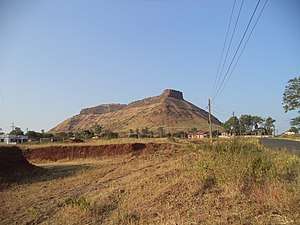 Ramshej fort from base village | |
 Ramshej Fort Ramshej Fort  Ramshej Fort Ramshej Fort (Maharashtra) | |
| Coordinates | 20.112195°N 73.767354°E |
| Type | Fort |
| Height | 3200 feet |
| Site information | |
| Owner | Govt. of India |
| Controlled by |
|
| Open to the public | Yes |
| Condition | Ruins |
| Site history | |
| Materials | Stone |
| Garrison information | |
| Past commanders | Suryaji Jadhav |
History
Ramsej fort saw the war against Mughal Empire for six and a half years.[1] The first killedar (fort commander) was Suryaji Jadhav, but after five and a half years he was transferred and a new killedar was appointed as per the rotation of posts policy of Maratha empire. In 1682 Aurangzeb sent Sahabuddin Khan to conquer the fort. Shahbuddin Khan had vowed to capture the fort with his 40,000 army and strong artillery within a few hours. But the 600 Maratha soldiers on the fort kept his forces at bay for many months by fierce array of slingshots, lit haystack and huge stones even though they did not have cannons on the fort. Once the Mughal artillery managed to break the fort walls in the evening and they assumed that the fort will be captured easily. But all 600 Marathas on the fort worked for a full night and rebuilt the entire broken section of the wall, much to the despair and awe of the Mughals. Such fierce resistance made the Mughal soldiers believe that the Marathas on the fort knew black magic. The inability of Mughal Sardar to capture the fort started frustrating Aurangzeb. He raised a wooden platform to storm the fort. Marathas were very smart in the fact that Shivaji and his son Sambhaji had a policy of keeping enough ammunition even on the forts having no cannons or guns. Ramshej was no exception and even though it did not have cannons it had sufficient ammunition. The fort commander had an idea and utilised amply available animal skin and wood on the fort to make wooden cannons. Coupled with the ammunition already present on the fort these wooden cannons started inflicting heavy losses on mughal army. The retaliation from the Marathas was so strong that he left the responsibility to Bahadurkhan and went to Junnar. Bahadurkhan also tried to capture the fort by fooling Marathas into believing that the Mughals were preparing for a full fledged frontal assault. While his real plan was send 200 of his best troops from the rear side of the fort by climbing the steep cliff. The Maratha commander was aware of the fact and allowed these 200 soldiers to climb the rope. Once they had climbed up the rope, he cut the rope as a result of which 200 of the best mughal soldiers fell and died in the valley. Bahadurkhan was distraught and found that Marathas were receiving secret supplies from the nearby forts. He carefully blocked all the paths to nearby Maratha forts. There was dire shortage of food on the fort. Seeing this situation Maratha King Sambhaji acted quickly by sending his sardars Rupaji Bhosle and Manaji More with an 8,000 strong army and supplies. They tried to break through the Mughal line but we're unable to supply the fort. Sambhaji was in great worry that his fiercely brave warriors were fighting without food. But the luck supported the Marathas and due to severe bad weather Bahadurkhan relaxed his encirclement for one day enabling Rupaji and Manaji to supply the fort with supplies enough for 6 more months. Bahadurkhan then tried to win the fort with the help of a 'mantrik' as he believed that the Marathas had ghosts under their control. The Marathas again fooled him as the mantrik was himself a maratha soldier in disguise who led the Mughal army in a deadly ambush of the marathas. Bahadurkhan and Mughals fled the deadly ambush and several Mughals were killed in this surprise attack. Bahadurkhan was also unable to siege the fort, finally, he burnt the wooden platform and left the battle. Aurangzeb sent Kasim Khan Kirmani to lead the battle[2] and it is said that the Mughals conquered Ramshej Fort by paying bribe to the new killedar.[1] Ramsej was one of the forts which surrendered to British Army in 1818 after the fall of Trymbakgad fort.[3] Captain Briggs describes that there were eight guns, 9 small cannons called jamburasand 21 jingals on the fort.
Places to see
The fort is located on a high tableland with escarpments on all the sides. There are good steps on the eastern side of the fort which lead to the entrance gate. There is a temple of Lord Ram at the entrance of the fort. There is a water cistern near the temple holding potable water. On the eastern side of the fort is the main gate of the fort which is chiseled from the parent rock. There are many rock-cut water cisterns on the fort. The hidden entrance gate on the eastern side of the fort leads the path to Bhorgad fort.
Gallery
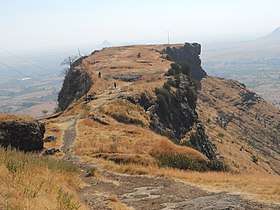 plateau on Fort
plateau on Fort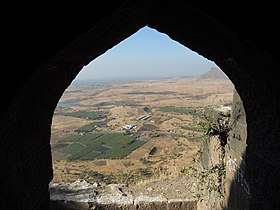 Outside view
Outside view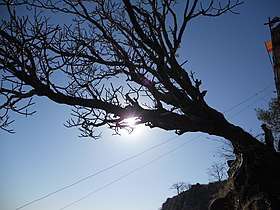 Sunshine on the fort
Sunshine on the fort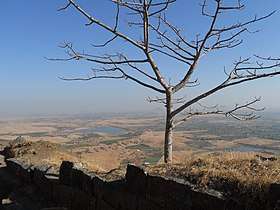 Tree stood alone on the fort
Tree stood alone on the fort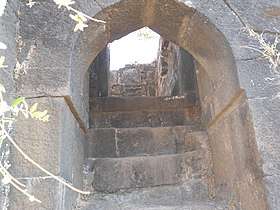 Staircase
Staircase- Rockcut water cistern
- Inscriptions on the temple wall
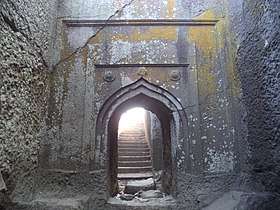 Main entrance gate
Main entrance gate
See also
- Siege of Ramsej
- List of forts in Maharashtra
- List of forts in India
- Sambhaji
- Marathi People
- List of Maratha dynasties and states
- Maratha War of Independence
- Battles involving the Maratha Empire
- Maratha Army
- Maratha titles
- Military history of India
- List of people involved in the Maratha Empire
References
4. Sambhaji - Vishwas Patil
. 5. Khara Sambhaji - Namdeorao Jadhav
6. Chatrapati Sambhaji Maharaj - Indrajit Sawant
7. Chhava - Shivaji Sawant